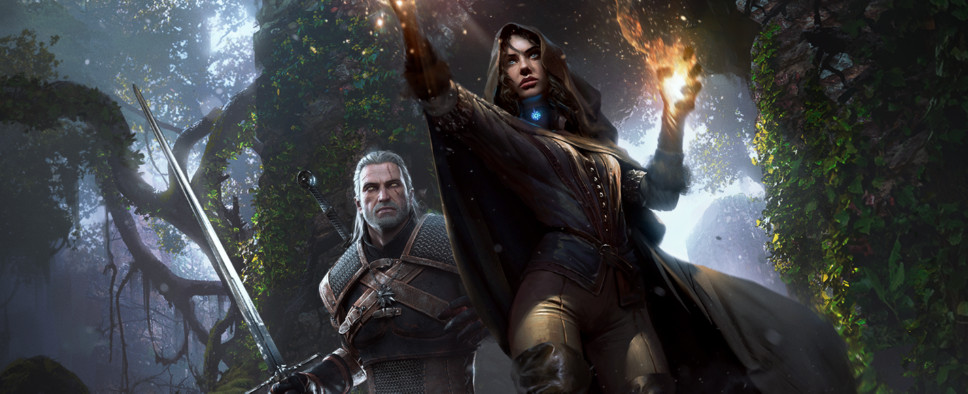The Witcher 3: Wild Hunt Review
-
Category: ReviewsHits: 31613

Article Index
Overall, the game's combat system does the job but nothing more. A lot of the problems from The Witcher 2 are still present, but between the easier difficulty curve (the game is only moderately challenging at the start), and increased mobility options and responsiveness, it's perfectly serviceable. It's not the kind of combat that could ever support a whole game on its shoulders, but it made me groan a lot less than I had in the past with the series. I did still groan, however.
The Witcher 3 also includes a number of side activities that I'd be remiss not to mention. There is Gwent, a card game that replaces dice poker. I thought I'd miss dice poker, and I still do, but Gwent won me over. It can feel a little counterintuitive at first in terms of ruleset, but it's a fun and surprisingly engaging diversion, with a decent amount of depth. It wouldn't hold up in the real world, though, due to the prevalence of a few obvious winning tactics.
Horse racing isn't particularly fun. The tracks aren't signposted well enough, the controls are cumbersome, and the other riders don't seem to have to deal with the same stamina constraints the player has to. I ended up winning the harder races by positioning myself in front of the other racers while I was trying to regain stamina, which felt like cheating and didn't remind me of horse racing at all. The game occasionally expects you to chase people on horseback too, and that's painful.
Finally, there is fistfighting. While in The Witcher 2 it was a simple QTE minigame, fistfighting in The Witcher 3 uses the same controls as the normal combat, though the options are more limited (it's not possible to use signs and the attacks have obviously a shorter range). Initially it's on the easy side, but it soon turns into a more elaborate activity the requires you to study the fighting style of high level opponents. Not mind blowing, but certainly enjoyable.
Character Progression and Gear
The Witcher 3: Wild Hunt's character progression system is a bit of a mess. I spent a lot of time thinking about the way CD Projekt handled leveling, and I still have no idea what they were hoping to accomplish. A bit of context: every time Geralt levels up he obtains a slight stat boot and an ability point. Ability points can be spent on skills, which are divided into four skill trees: Combat, Signs, Alchemy and General.
Once obtained, skills have to be slotted, and this is where The Witcher 3 gets slightly weird. Geralt starts with only three skill slots, and progressively unlocks more, for a total of 12 slots. There are also four mutagen slots, that can be freely swapped. The mutagens synergize with the trio of skills they're placed next to: the more skills of the same color (red for Combat, blue for Signs, green for Alchemy), the stronger the effect of the mutagen will be.
About the only advantage I can think for this sytem is that it maintains a semblance of character build even Geralt is fully leveled up, but it also takes away the pleasure of being overleveled in the first place and too aggressively pares down the amount of skills available at any given time. It also negatively affects the relationship between the player and character advancement: to get the most out of Geralt at an early level a player has to commit to a skill branch.
There are also a few other nitpicks: a lot of the early Combat skills are very boring, a few of the General skills end up being phased out very quickly, and the Alchemy abilities' effects are very poorly explained. I'd be more than willing to pass over these, though, if I felt the general design was more sound and had a clear direction, which I don't. At this point I'm starting to wonder whether it was a good idea to mix skill trees with a premade character with iconic abilities.
Loot isn't very good either. As usual, Geralt uses both a silver and a steel sword, though it's still possible to loot and equip other types of weapons. There are also various crossbow and bolt types, armors that come in three types (light, medium and heavy) that affect your playstyle, and trophies, which can be obtained by boss monsters and offer different stat bonuses. It's all very standard and very solid stuff, so no complaints here.
What doesn't work, however, is the distribution of loot and the progression curve. This is due to a mix of underpowered quest rewards and swingy loot tables. A roll of the game's internal dice can determine the difference between finding some common items or a rare piece of equipment, which will more often than not be better than one specifically crafted for Geralt as a reward for a very long quest chain.
To exacerbate the issue, there are level limits on equipment. It's perfectly possible to craft or find amazing items, just to discover that Geralt can't use them yet because he's not at the right level. It's a mechanic that cheapens the power curve and diminishes the rewards for exploration in an open-world game. Just like with the character progression system, I can't think of a real reason for this design decision, which makes it all the poorer in my eyes.

